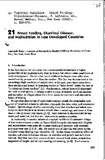Mostrar el registro sencillo del ítem
Breast feeding, Diarrheal Disease, and Malnutrition in Less Developed Countries
| dc.creator | Mata Jiménez, Leonardo | |
| dc.date.accessioned | 2015-07-23T14:39:35Z | |
| dc.date.available | 2015-07-23T14:39:35Z | |
| dc.date.issued | 1982 | |
| dc.identifier.uri | https://hdl.handle.net/10669/15091 | |
| dc.description | Capítulo de libro -- Universidad de Costa Rica, Instituto de Investigaciones en Salud. 1982 | es_ES |
| dc.description.abstract | It has been known for centuries that non-breast-fed infants have a higher probability of dying prematurely than do breast-fed infants under conditions of underdevelopment. On the other hand, artificial feeding is more risky when carried out by persons other than the mother. The fact was documented in the exceedingly high mortality of infants who, in the past, were taken away from their mothers and placed in foundling homes or "baby farms" under the care of "professional foster mothers". Furthermore, infants born with abnormalities such as cleft palate, or infants unable to suck, invariably die from diarrhea and starvation in villages where there is no access to treatment and alternative forms of feeding. Prospective observation of traditional societies reveals the remarkable resis- Sisonce of breast-fed infants to infection, especially diarrhea, otitis, and respiratory disease. Epidemiologic studies consistently show that diarrhea and infant mortality are more frequent in weaned infants than in weanlings, and more in these than in wholly breast-fed infants. Such behavior is characteristic in less developed countries, but it is also observable in modem societies. In exclusively breast-fed infants of a typical traditional Guatemalan village of low socioeconomic condition (Santa Maria Cauqué, infections with Shigella and enteroviruses were generally asymptomatic and transient, and intestinal protozoa were rare [2,6-8] ; also, the attack rate of diarrhea was lower during exclusive breast feeding than thereafter. In this village the adverse effect of diarrhea and other infectious diseases on nutrition and growth was well documented. Diarrhea was often associated with reduced food intake, weight loss, stagnation of height, and chronic wasting and stunting [6-9]. Furthermore, studies conducted by our institute in a different rural dispersed population, in Puriscal, Costa Rica, also showed that diarrhea is more frequent in infants in the process of weaning or in those totally weaned than in breast-fed infants, despite the fact that children were relatively well nourished as they grew above the 25th percentile of the National Center for Health Statistics reference curve. The PAHO Interamerican Study of Childhood Mortality had already revealed a strong association between diarrheal disease and malnutrition and between these and infantile death in representative cities of the Americas. Thus diarrhea is the main cause of chronic malnutrition in tropical regions where famine and natural disaster are not usual problems; also, diarrhea is the commonest precipitating factor of acute protein-energy malnutrition and premature death in less developed countries. | es_ES |
| dc.description.sponsorship | Universidad de Costa Rica. Instituto de Investigaciones en Salud | es_ES |
| dc.language.iso | en_US | es_ES |
| dc.publisher | Pediatric Nutrition. Infant Feeding- Deficiences - Diseases p. 355-372 | es_ES |
| dc.source | F. Lifshtz. (Editor). Pediatric nutrition. Infant feeding deficiencies diseases. Marcel Dekker, Inc., N.Y., U.S.A. 1982: 355-372 | es_ES |
| dc.subject | diarrea infantl | es_ES |
| dc.subject | trastornos nutricionales del lactante | es_ES |
| dc.subject | Diarrhea | es_ES |
| dc.subject | Demografía | es_ES |
| dc.subject | Nutrición del niño | es_ES |
| dc.subject | Child development | es_ES |
| dc.subject | Nutrition | es_ES |
| dc.title | Breast feeding, Diarrheal Disease, and Malnutrition in Less Developed Countries | es_ES |
| dc.type | capítulo de libro | |
| dc.description.procedence | UCR::Vicerrectoría de Investigación::Unidades de Investigación::Ciencias de la Salud::Instituto de Investigaciones en Salud (INISA) | es_ES |


